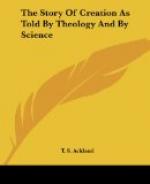with reference to us. They both give a continuous
spectrum. The one in Bridanus is described as
“an eleventh magnitude star, standing in the
centre of a circular nebula, itself placed centrally
on a larger and fainter circle of hazy light.”
[Footnote: Lassell, quoted in Webb’s “Celestial
Objects,” p. 227.] The nebula in Andromeda assumes
a lenticular form; that in Bridanus would probably
present the same appearance if we saw it edge-ways.
The former has probably increased in brilliancy in
the course of centuries. Mr. Webb remarks of
it, “It is so plain to the naked eye that it
is strange the ancients scarcely mention it.”
[Footnote: Webb’s “Celestial Objects,”
p. 180.] In these two nebulas we may perhaps see the
mass ready to break up into separate worlds, the lenticular
form being a natural result of extremely rapid rotation.
Prom the fact that Andromeda 116 gives a continuous
spectrum, Dr. Huggins inclines to the belief that it
is an unresolved star cluster. But the reasons
which led Sir W. Herschel to conclude that the nebula
in Orion was gaseous, (a conclusion which, though
for a time discredited by the supposed resolution of
the nebula in Lord Kosse’s telescope, was ultimately
found to be correct), are equally applicable here.
In general a certain proportion exists between the
telescopic power requisite to render a star cluster
visible as a nebulous spot, and that which will resolve
it into stars; but this nebula, like that in Orion,
though visible to the naked eye, cannot be resolved
by the most powerful instruments yet made. And
the nebula in Draco 4373, seems to present an intermediate
stage between the purely gaseous nebula and this one.
The faint continuous spectrum is probably the result
of incipient central condensation. This nebula,
if recent observations by Mr. Gill, of Aberdeen, are
confirmed [Footnote: Popular Science Review,
1871, p. 426.], is much nearer to us than any of the
fixed stars.
“We come now to the reasons derived from the
Solar System itself, and of these there are several,
some of them of considerable weight. The first
is to be found in the uniform direction of almost
all the motions of the system. They are from west
to east. The sun rotates upon his axis, the planets
revolve about the sun and rotate upon their axes,
and the satellites, with one exception, revolve about
their primaries, and, so far as is known, rotate upon
their axes in the same direction, from west to east,
and the motions take place very nearly in the same
plane—the ecliptic. This seems to
point to the conclusion that these motions have a
common origin, as would be the case if all these bodies
at one time existed as a single mass which revolved
in the same direction. The one exception is to
be found in the satellites of Uranus, whose motion
is retrograde. But there are certain phenomena,
which lead to the conclusion, that, on the outskirts
of our system, there has at some time or other been
an action of a disturbing force, of which, except
from these results, we know nothing.”




